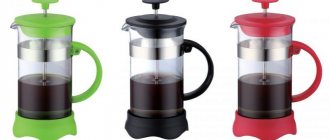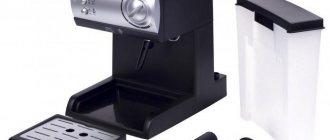Created: 12/24/2018
Updated: 03/02/2021 19:39:05Share:
*Review of the best according to the editors of expertology.ru. About the selection criteria. This material is subjective in nature, does not constitute advertising and does not serve as a purchase guide. Before purchasing, consultation with a specialist is required.
Almost everyone loves coffee, and many cannot imagine their morning without an aromatic and invigorating drink. Today you can purchase various multifunctional units that do not require special skills and automatically do everything for a person. But true coffee connoisseurs remain faithful to the traditional attribute - Turk.
The first vessel was used in ancient times. African nomads took large copper pots with them and brewed a tart drink in it. Gradually, due to the inconvenience of transportation from place to place, the dimensions decreased. And the pots turned into small jugs with long handles and spouts.
After the spread of such utensils on the Arabian Peninsula, it gradually began to change and turned into the familiar Turkish cezve. The narrowed throat prevented the drink from spilling. With the help of an extended handle, the cooking process has been simplified and made much more comfortable.
How to choose a Turk for brewing coffee
How to choose a Turkish coffee pot among the variety of products so that it is not only comfortable, but also produces only the highest quality coffee? Expert advice will help you make the right purchase.
- The traditional Turk has a cone shape. In it, the grains settle faster, and the foam becomes as clean as possible.
- The thicker the bottom and walls, the better. In such a Turk, uniform heating occurs, and the prepared coffee remains hot longer.
- To get a classic drink, you need to choose containers designed for 1-2 cups.
- For electric stoves, dishes with a smooth and flat bottom are more suitable, for gas stoves - with a rounded bottom.
- The copper Turk is the most practical, and its price is affordable for all buyers.
- Beginners can opt for transparent containers, which will help control the process and avoid coffee boiling over.
- The longer the handle, the more convenient it is. The heat-resistant material will allow you to use the cookware without using oven mitts. Thanks to the removable handle, you can wash the dishes better after cooking.
- In high Turks, the boiling process occurs more slowly, so the drink becomes richer and more aromatic.
- The built-in spout makes it easy to pour coffee into cups. The wider it is, the more convenient it is to do this.
- To achieve an ideal result, the diameter of the neck should be 2-3 times smaller than the diameter of the bottom.
- For a large family or group of friends, Turks with a volume of 500 ml or more are suitable.
What size pot is better?
The display cases contain products of completely different sizes. The design of the cezve gives the best results with maximum filling of the dishes. Therefore, it is best to buy a Turk of the size that you usually cook.
- A 100-150 ml cezve is the choice for individual preparation of 1 cup of coffee. It is also used for sand coffee recipe.
- The most popular Turkish format is 350 ml. It holds two cups of drink, so it is ideal for a coffee-loving couple.
- A 500 ml Turk is the best choice for a large family where 3-4 adults drink coffee.
- A 750 ml cezve is purchased for a company or a large family coffee drink.
Turks with a volume of 250-350 ml are in greatest demand. This size is considered universal.
Rating of the best Turks for making coffee
| Nomination | place | Name of product | price |
| The best copper turks | 1 | Stanitsa “Mednaya”, 500 ml | 989 ₽ |
| 2 | Turk Mayer & Boch 750 | 810 ₽ | |
| 3 | Stanitsa "Grace", 350 ml | 918 ₽ | |
| 4 | TimA TU-550s | 724 ₽ | |
| 5 | Mallony “Oriental Beauty”, (art. 985223) | 905 ₽ | |
| The best stainless steel Turks | 1 | Vitesse “Turguoise”, 685 ml VS-8634 | 790 ₽ |
| 2 | Fissman, 550 ml. 3305 | 1 259 ₽ | |
| 3 | Padia, 340 ml (art. 6100-23) | 286 ₽ | |
| The best ceramic turks | 1 | Ceraflame Ibriks New 500 ml. D9375 | 2 417 ₽ |
| 2 | Gutenberg "Oriental Mosaic", 200 ml (C09-200) | 2 069 ₽ | |
| 3 | Ceraflame “Ibriks Hammered” (art. D9409) | 2 890 ₽ |
Turk with which handle is better
The main process takes place in the body of the cezve, but a comfortable and strong handle is an important factor in ease of use. Which handle for a Turk will be the most suitable?
Material of manufacture
- Metal. Such handles are usually found in cheap aluminum bowls. Metal holders heat up quickly, so be sure to use oven mitts for them.
- Tree. Handles for copper and sometimes ceramic Turks are made from it. The wood does not heat up and allows you to take dishes with an unprotected hand.
- Plastic. Nowadays the so-called bakelite is popular. It does not heat up, does not melt, and is lightweight. It is from this that holders for glass and steel Turks are made. Sometimes it is used for copper cookware.
Fastening
- Bolted on. In this case, the holder is attached to the body using two bolts, their heads are visible on the inside of the Turk. The fastening is reliable, lasts a long time and has proven itself well.
- On the solder. Soldered handles are less reliable. Modern Turks are coated with various compounds to prevent them from oxidizing. These compounds sometimes interfere with the quality of adhesion during soldering. Therefore, handles soldered to the Turk may fail at the most inopportune moment.
It is best to have a Turk with a wooden or bakelite handle secured with bolts.
The best copper turks
Stanitsa “Mednaya”, 500 ml
Rating: 4.9
The first place is taken by a classic-shaped Turk with a volume of 500 ml. It is made from copper coated with a protective layer on top. The interior is treated with food-grade tin, which prevents oxidative processes and makes the model safe to use for health. A narrow neck contributes to the preparation of a tart, aromatic drink.
The handle is quite long, comfortable, and made of natural wood. It will help make the coffee preparation procedure more comfortable and eliminate the risk of burns. With the help of a metal ring, the Turk can not only be stored on a shelf, but also hung on a hook. The sophisticated design makes it a stylish piece in the kitchen. Turka will be an excellent gift option for coffee lovers for any occasion.
Many users noted the excellent appearance and preparation of truly real coffee with an invigorating aroma and richness. Turka is highly durable, resistant to deformation, and the inner layer is not scratched. An important quality is the ability to wash in the dishwasher.
Advantages
- for making coffee of any kind;
- heat-resistant wooden handle;
- presence of a spout;
- safety;
- ideal ratio of bottom and neck diameters;
- Durable internal tin lining.
Flaws
- not detected.
Turk Mayer & Boch 750
Rating: 4.8
The second place in the ranking is taken by the Turkish brand Mayer & Boch. It is made of high quality copper with an outer plating of black nickel. The volumetric design attracts attention and makes coffee making more enjoyable. The interior is coated with food-grade tin for safe use of copper cookware.
The Turk ensures uniform heating. A narrow neck allows the powder to quickly settle to the bottom and makes the foam more free from impurities. The high side creates optimal conditions for adding richness to the drink and preserving its aromatic properties. The carved wooden handle allows you to quickly remove the Turk from the stove at the moment of boiling. It does not heat up and prevents burns.
The model can be used on all hobs except induction. It is not recommended to clean with abrasive agents or in the dishwasher. Many noted that the Mayer & Boch 750 Turk is suitable for making coffee for a large company; it produces a drink both according to the traditional recipe and according to the author’s one.
Advantages
- high quality copper;
- heat insulating handle;
- food grade tin coating;
- high sides – 13 cm;
- nice design;
- affordable price.
Flaws
- not detected.
What material is the best Turk?
The material of manufacture is the most basic parameter by which modern cezves differ. Which Turk is better - copper, ceramic, or maybe glass?
Aluminum Turk
For its manufacture, various grades of food grade aluminum alloys are used. The dishes are made by industrial stamping.
pros
- Easy. Aluminum alloy is a lightweight metal.
- Cheap. You can buy it for 200 rubles.
- Reliable. Doesn't break or break.
- Easy to care for. Does not require special operating conditions.
Minuses
- Minimum difference between the diameters of the neck and bottom. Even in the best samples, the required proportion of 1:2 is rarely observed. This leads to loss of aroma of the finished drink.
- Softness of metal. Aluminum is easy to scratch, bend or leave a dent on the body of the Turk.
- Budget design. Turks made of aluminum are unlikely to please with any special sophistication.
- Poor stability due to low weight.
An aluminum pot is good for making coffee on the go.
Copper (brass) Turk
It is made from copper alloys, most often from brass. On sale you can find mass-produced and hand-made products. Turks made of copper without impurities are much less common, because in its pure form the metal oxidizes too quickly, forming compounds that are unsafe for humans. But even brass cezves that are resistant to water and air must be coated with food-grade tin on the inside to prevent the slightest oxidation.
pros
- Cone shape
- Compliance with the required proportions of the bottom and neck. Therefore, the foam that forms during cooking reliably clogs the narrow neck. This preserves the aroma and taste of the drink.
- The thickened bottom promotes uniform heating of the vessel and uniform extraction of coffee powder.
- Reliability.
- Strength.
- Aesthetic appearance.
- Relatively affordable price. A copper Turk can be bought within 700-1000 rubles.
Minuses
- The need for periodic cleaning of the copper Turk.
- The walls of the Turk absorb odors well, especially with prolonged use.
The copper Turk is a classic example of coffee utensils that has proven its effectiveness over hundreds of years of history of its use.
Ceramic (clay) Turk
They are made from a mixture of clay, sometimes with the addition of plasticizers.
You can find handicraft and industrial clay Turks, glazed or without a protective coating. pros
- Environmentally friendly.
- Thick walls promote slow, smooth heating and uniform extraction of coffee powder.
- Variety of designs.
- Cone shape.
- Narrow neck and widened bottom in compliance with the required proportions.
Minuses
- Fragility.
- Instability to shock loads.
- The price is higher than copper and aluminum.
- Excessive decoration is common, which creates problems in daily care.
- Unglazed Turks have increased porosity, so they quickly absorb coloring pigments and odors.
The main advantage of ceramic Turks is its complete safety and environmental friendliness.
Glass Turk
Glass cezves began to be made not so long ago. They use borosilicate glass, which is heat resistant. They are made in factory conditions.
pros
- Aesthetically attractive appearance.
- Ability to control the coffee preparation process.
- Low price. Dishes with a volume of 500 ml can be bought for 350-550 rubles.
- Easy to maintain and use.
- Versatility of use. In a glass ladle you can heat water, milk, even cook soup if necessary.
Minuses
- Fragility
- Large volumes. Glassware for coffee is usually available with a capacity of 0.5 liters or more.
- Water boils too quickly. The required degree of extraction of coffee powder is achieved only by boiling coffee in a glass container, and this destroys the aroma and taste of the drink.
- A departure from the classic form. A neck that is too wide contributes to the loss of aroma and taste when brewing coffee.
The glass cezve looks stylish and modern, but is more suitable as a kitchen ladle for all occasions.
Silver Turk
Products made of silver of different standards often act as a gift or a memorable souvenir. They are produced in workshops or jewelry factories.
pros
- Beauty and grace.
- Classic cone shape with a narrow neck.
- Reliability.
Minuses
- High price.
- Special operating conditions and the need for regular cleaning.
- Excessive decorativeness. Not everyone is ready to use a cezve that costs 25 thousand rubles and more as a household appliance.
- Heats up too quickly. Silver has a very high thermal conductivity, much higher than that of copper and aluminum, so the water in such dishes will boil too quickly, and the coffee will be watery.
A silver Turk is a good and expensive gift, a design element, but it is not suitable for practical use.
Stainless steel Turk
Another product of an industrial society, made of a steel alloy with the addition of chromium or zinc in order to avoid metal oxidation processes. The stainless steel cezve is made in a factory.
pros
- Ease.
- Easy to care for.
- Strength.
- Low price.
- Reliability.
Minuses
- Wide neck.
- Smooth walls and the same metal thickness over the entire surface, without thickening the bottom. This causes the water to boil too quickly, which prevents the coffee powder from being extracted slowly and evenly.
- Large volumes - from 400 ml, but most often dishes are produced in 500 and 750 ml.
Stainless steel cookware can only be called Turkish out of politeness. This steel ladle is durable, convenient and versatile.
The nuances of choosing a handle
Having figured out how to choose a Turk based on the type of material, you need to pay attention to the issue of selecting a handle. It should be as comfortable as possible, because during the process of brewing coffee the need for this detail arises repeatedly. In most Turks, the handle is slightly raised up, and sometimes located almost vertically.
All-metal models are not uncommon in copper, brass, and steel products. They are also made as a separate element from non-heating materials - thermoplastic, wood. Mounted in two ways:
- soldering;
- bolts.
The latter is more reliable, since the soldering breaks down over time. The handle can also be removable - plug-in or screw-on. When purchasing, you should pay attention to its location on the metal Turk. Too short a distance may cause burning.
If the choice fell on a ceramic Turk, you should give preference to cast and hollow handles.
History of the invention of the Turks
Information about the date of the first preparations has been lost for centuries, but the chronology of the emergence, development and improvement of the devices in which real coffee was prepared has been preserved.
There are two versions of the origin of the name of the cooking utensil.
- From the Arabic word جذوة (jadhwa) - translated as “smoldering coals” - which sounds like “dzhezva” in Russian and means a forged copper ladle of a peculiar shape, intended for brewing coffee.
- From the Turkish “sezve” - coffee pot.
In our country, this kitchen utensil is called a Turk because of its purpose for brewing Turkish coffee.
Many people are interested in the differences between Turks and cezves. There is no difference - it's the same thing.
In our country, this kitchen utensil is called a Turk because of its purpose for brewing Turkish coffee.
When was the first Turk created?
Nomadic African tribes were the first to learn how to make coffee about a thousand years ago. They used copper and bronze utensils, reminiscent of modern cauldrons, in which the drink was boiled over a fire.
The tradition was adopted from the Africans by the Bedouin nomads, who used irbiki for cooking - stable traveling jugs with a long neck and spout, closed with a lid. They held about 100 ml of liquid and were originally used for water.
Irbiks have been used for several centuries and are considered the first devices for making coffee.
Tribes leading a nomadic life began to populate the Arabian Peninsula, where eastern merchants became interested in the recipe, who considered the drink worthy of a ruler and delivered it to the Sultan, whose cooks began to cook it in a small golden saucepan with a lid and handle (so that no one’s breath would desecrate its divinity). But in such a vessel, coffee quickly heated up and often burned, so the ruler ordered it to be improved. The updated version was made of tinned copper, widened at the bottom and narrowed at the top and called “dalla”.
The updated version was made of tinned copper, widened at the bottom and narrowed at the top and called “dalla”.
Around the Sultan, a tradition arose of having conversations over a cup of coffee, this gave the drink popularity, and it spread among the rich. Later, metal dalls appeared for the poorer classes.
In 1554, coffee houses began to open in the Ottoman Empire, which were very popular. The people who gathered there gossiped and slandered the authorities, so they were soon converted into hairdressing salons, and coffee was banned. But lovers of the drink did not abandon it, but began to prepare it secretly.
European aristocrats adopted the recipe from the eastern inhabitants, Russians - from the Turks. Only the name “cezva” did not take root in our country, and as a result of mass distribution, its own name appeared - “Turk”.
European aristocrats adopted the recipe from the eastern inhabitants, the Russians from the Turks.
Shape Features
Modern cezves come in a variety of shapes, but most of them do not make better coffee. The most aromatic drink can still be obtained only by preparing it in a classic Turk, which has:
- An expansion into which a narrow neck passes, which performs the function of trapping foam (the larger it is, the better);
- Narrowed neck, which prevents the evaporation of volatile esters, which give the drink a special taste and aroma;
- Conical shape, ensuring sedimentation of the grounds, minimal foaming and its concentration in the narrow part of the turk;
- A wide bottom promotes uniform heating of the dishes and the liquid contained in it.
True coffee connoisseurs know that choosing the right Turkish coffee is a guarantee of excellent taste and aroma.
True coffee connoisseurs know that choosing the right Turkish coffee is a guarantee of excellent taste and aroma.
Tips for choosing
To choose a really good Turk for brewing real coffee, you should consider a few tips:
- If the drink is intended for one person, there is no need to consider products with a volume of more than 100 ml.
- You can prepare coffee with a rich taste only in a classic cone-shaped Turk.
- The thinner the walls of the product, the faster the liquid will heat up, and the less quality the drink will be.
- For those who hardly know how to use a Turk and are looking for a universal option, copper, brass, and cupronickel models are suitable.
- True gourmets should pay attention to high quality ceramic or clay products.
- The more securely the handle is attached, the longer the cezve will last.
- The minimum number of decorative elements is the key to easy maintenance.
When buying a Turk, you also need to take into account the type of stove. Induction and glass-ceramic models require a special approach to the selection of cookware and household appliances.
Copper cezve - a living classic
Next you should look at the material from which it is made. It is of no small importance. The cezve can be:
- ceramic (clay);
- copper;
- steel;
- aluminum;
- glass (crystal).
The most expensive option can be considered a silver vessel for making coffee. However, its practicality in daily use is low. Aesthetics and beauty don’t count.
If you need a durable and safe coffee pot, which one to choose, further advice will help. The classic version is a copper vessel. The inside is coated with brass to avoid oxidation, which is unsafe and affects the taste of the drink. It is this kind of dishes that have the correct shape, thickness and are often decorated with original embossing.
Helpful Tips and Reminders
Based on the above, we can draw a conclusion about how to choose a Turk for coffee.
This must be done responsibly and carefully; there are many options. The best choice for gourmets would be a copper vessel of rich color, and for people who prefer environmentally friendly materials - a ceramic one.
The fewer decorative elements on a product, the better. It’s good if there is a removable, non-heating handle - it will be easier to wash the container.
Do not use abrasive or aggressive substances for cleaning, otherwise the coffee will absorb their smell. After using it at home, rinse the vessel with hot water while wiping it with a sponge.
In general, which Turk is better to brew coffee in is an individual choice.
Interesting! How to clean a copper pot well at home
Terms of use
There are many freely available recipes and recommendations on how to properly brew Turkish coffee. Traditional method:
- Pour in coffee, add sugar if necessary, lightly fry the mixture, stirring constantly.
- Add water and leave the Turk over very low heat.
- After the foam has formed and risen to the edge, remove the cezve from the heat and let the foam settle.
- Put the dish back on the fire and repeat the same steps 3-4 more times.
When preparing coffee, the main thing is not to bring it to a boil, otherwise the drink will lose its proper taste and aroma.
At the end of the process, the Turk must be washed with warm water using a soft sponge without abrasive or detergent substances. There is no need to try to remove the formed film from coffee oils; it is enough to rid the dishes of the remaining grounds. Over time, carbon deposits form on the outside. Methods for removing it depend on the type of material it is made of; lemon, vinegar, and soda are universal means.
Review of Turkish manufacturers
True coffee connoisseurs purchase exclusive models made by professionals in a single copy. Such cezves have a unique design, often decorated with hand-made molding and drawings. They are much more expensive in price than those produced on a production scale. If it is not possible to purchase a handmade Turk, check out the list of the most famous companies specializing in the production of coffee utensils:
- Bekker (Germany);
- TimA (RF);
- Vitesse (China);
- Regent (co-production between Italy and China);
- Stanitsa (RF).
The listed manufacturers produce high-quality models using only reliable, proven materials. Products are subject to strict quality control and meet international standards. By choosing any of these companies, you can be sure that the model will last a long time and will delight you with a freshly brewed aromatic drink. Each manufacturer offers a wide selection of different coffee tableware options, so consumers can choose any model they like.
What design of Turk is better?
Each user decides this question himself, based on individual tastes. But there are points that you need to remember when choosing the best Turk.
- Dark-colored cezves retain their elegant appearance longer. Even copper Turks are sometimes made with a patina effect so that the darkening that is inevitable over time is not so noticeable.
- The abundance of decorative elements - modeling, appliqués, overlays - may make the Turk more elegant, but makes it difficult to care for her daily. The fewer depressions and depressions on the surface, the easier it is to clean.
- Regular heating can weaken the fastening of applied decors, so it is better to choose a Turk without such elements. The metal surface can be decorated with shallow embossing or engraving, which is easy to clean even when darkened.
Shape and size
The classic shape of a vessel for brewing coffee: a wide bottom, a narrow neck, an expanding foam container and a long handle. The specific shape allows ground beans mixed with water to quickly heat up and rise to the neck. The collected “plug” helps to uniformly mix the particles throughout the entire height of the vessel.
Along with the conical shape, there is a cylindrical shape of the vessel. In Arab countries, barrel-shaped coffee ladles are also used. In height, Turks are low and flattened, flat or tall.
Turks bell allows you to stop rising foam in time
A significant role in the design of the vessel is played by the socket for catching the foam - it allows you to set the boiling pot on time on the edge of the stove.
Dimensions:
- 70 – 120 ml – for very strong oriental coffee, for 1-3 persons
- 200 – 220 ml – weak coffee for 1-3 persons
- 220 – 350 ml – weak coffee for 2-5 persons
- 400 – 500 ml – Turk for brewing coffee for 5-7 people










